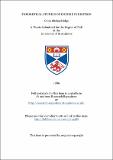Theoretical studies of enzyme inhibition
Abstract
The glyoxalase enzyme system catalyses the conversion of methylglyoxal to D-lactic acid. The first of the two component enzymes, glyoxalase I, is responsible for the transfer of two protons in an iscmerisation reaction. This enzyme has been ascribed a role in tumorigenesis in the past and some of its inhibitors are known to be carcinostatic. This thesis describes quantum chemical calculations on the enzyme mechanism and on some enzyme inhibitors. The calculations on the mechanism of the enzyme take the form of studies of model reaction schemes, with minimal and split-valence basis sets. The calculation of the energies of various intermediates has led to the evaluation of different pathways as models of the enzyme mechanism. The comparison of different substituted compounds has led to further conclusions on the part played by the sulphur atom in the enzyme-catalysed reaction. Two main groups of inhibitor molecules are discussed; these are flavone and coumarin derivatives. The molecular electrostatic potential of these molecules has been calculated on various surfaces, using a minimal basis set, to attempt to correlate this property with the compounds' inhibitory power. A FORTRAN program is presented which depicts calculated properties on the surfaces. This program allowed the identification of various regions which seemed to be indicative of the inhibitory strength of the compounds.
Type
Thesis, PhD Doctor of Philosophy
Collections
Items in the St Andrews Research Repository are protected by copyright, with all rights reserved, unless otherwise indicated.

